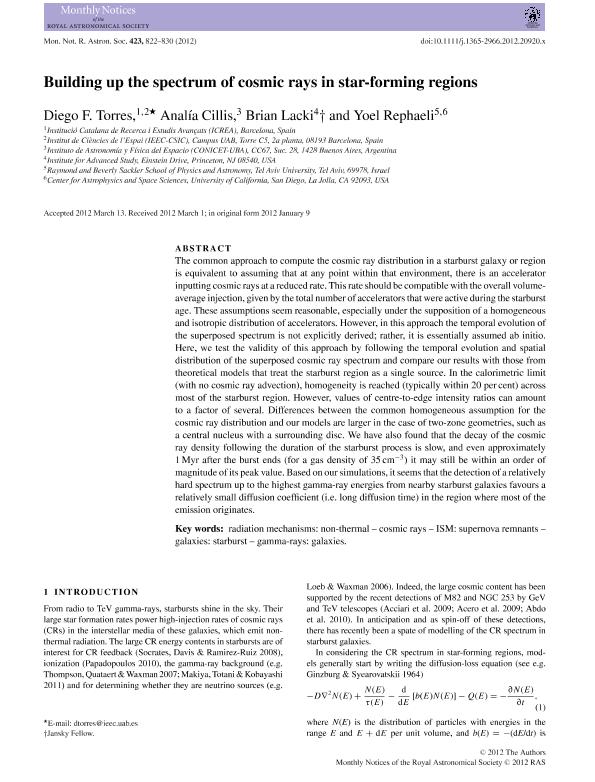Mostrar el registro sencillo del ítem
dc.contributor.author
Torres, Diego F.

dc.contributor.author
Cillis, Analia Nilda

dc.contributor.author
Lacki, Brian
dc.contributor.author
Rephaeli, Joel
dc.date.available
2017-06-30T19:25:25Z
dc.date.issued
2012-06
dc.identifier.citation
Torres, Diego F.; Cillis, Analia Nilda; Lacki, Brian; Rephaeli, Joel; Building up the spectrum of cosmic rays in star-forming regions; Oxford University Press; Monthly Notices of the Royal Astronomical Society; 423; 1; 6-2012; 822-830
dc.identifier.issn
0035-8711
dc.identifier.uri
http://hdl.handle.net/11336/19309
dc.description.abstract
The common approach to compute the cosmic ray distribution in a starburst galaxy or region is equivalent to assuming that at any point within that environment, there is an accelerator inputting cosmic rays at a reduced rate. This rate should be compatible with the overall volume-average injection, given by the total number of accelerators that were active during the starburst age. These assumptions seem reasonable, especially under the supposition of a homogeneous and isotropic distribution of accelerators. However, in this approach the temporal evolution of the superposed spectrum is not explicitly derived; rather, it is essentially assumed ab initio. Here, we test the validity of this approach by following the temporal evolution and spatial distribution of the superposed cosmic ray spectrum and compare our results with those from theoretical models that treat the starburst region as a single source. In the calorimetric limit (with no cosmic ray advection), homogeneity is reached (typically within 20 per cent) across most of the starburst region. However, values of centre-to-edge intensity ratios can amount to a factor of several. Differences between the common homogeneous assumption for the cosmic ray distribution and our models are larger in the case of two-zone geometries, such as a central nucleus with a surrounding disc. We have also found that the decay of the cosmic ray density following the duration of the starburst process is slow, and even approximately 1 Myr after the burst ends (for a gas density of 35 cm-3) it may still be within an order of magnitude of its peak value. Based on our simulations, it seems that the detection of a relatively hard spectrum up to the highest gamma-ray energies from nearby starburst galaxies favours a relatively small diffusion coefficient (i.e. long diffusion time) in the region where most of the emission originates.
dc.format
application/pdf
dc.language.iso
eng
dc.publisher
Oxford University Press

dc.rights
info:eu-repo/semantics/openAccess
dc.rights.uri
https://creativecommons.org/licenses/by-nc-sa/2.5/ar/
dc.subject
Radiation Mechanisms: Non-Thermal
dc.subject
Cosmic Rays
dc.subject
Supernova Remnants
dc.subject
Starburst
dc.subject.classification
Astronomía

dc.subject.classification
Ciencias Físicas

dc.subject.classification
CIENCIAS NATURALES Y EXACTAS

dc.title
Building up the spectrum of cosmic rays in star-forming regions
dc.type
info:eu-repo/semantics/article
dc.type
info:ar-repo/semantics/artículo
dc.type
info:eu-repo/semantics/publishedVersion
dc.date.updated
2017-06-30T17:28:05Z
dc.journal.volume
423
dc.journal.number
1
dc.journal.pagination
822-830
dc.journal.pais
Reino Unido

dc.journal.ciudad
Londres
dc.description.fil
Fil: Torres, Diego F.. Institució Catalana de Recerca i Estudis Avancats; España
dc.description.fil
Fil: Cillis, Analia Nilda. Consejo Nacional de Investigaciónes Científicas y Técnicas. Oficina de Coordinación Administrativa Ciudad Universitaria. Instituto de Astronomía y Física del Espacio. - Universidad de Buenos Aires. Facultad de Ciencias Exactas y Naturales. Instituto de Astronomía y Física del Espacio; Argentina
dc.description.fil
Fil: Lacki, Brian. Institute for Advanced Study; Estados Unidos
dc.description.fil
Fil: Rephaeli, Joel. University of California; Estados Unidos
dc.journal.title
Monthly Notices of the Royal Astronomical Society

dc.relation.alternativeid
info:eu-repo/semantics/altIdentifier/url/https://academic.oup.com/mnras/article-lookup/doi/10.1111/j.1365-2966.2012.20920.x
dc.relation.alternativeid
info:eu-repo/semantics/altIdentifier/doi/http://dx.doi.org/10.1111/j.1365-2966.2012.20920.x
Archivos asociados
